► Seat Ateca long-term test review
► Testing the 1.4-litre petrol Xcellence
► We live with the SUV for half a year
Month 6 living with a Seat Ateca crossover: we’re convinced!
So an email pinged into my inbox from CAR contributing editor Ben Whitworth: it turns out he’s in the market to downsize his Alhambra MPV for a crossover, and wants to try the Ateca for a few days.
The Seat’s temporary disappearance helped hone my conclusions ahead of its finite departure. Big question #1: after five diesel cars in a row, how did a teeny turbo petrol engine cope with the life McNamara? Chugging around in Whitworth’s diesel Grand Scenic, I missed the 1.4 EcoTSI’s silent idle and motorway hush. And while the Renault dCi rolls on a wave of easy torque, the Ateca’s four pot does a useful imitation of that surge above 1900rpm: beware a hollow spot at lower crank speeds. Note that the engine didn’t suit CAR’s less sedate types, but with the Ateca averaging 36.7mpg – 3mpg better than preceding Disco Sport and Evoque diesels – it’s converted me to the green pump.
Big Q #2: what’s life like on board? Ben W inhaled that lowballed part-ex hiss when we met for the handover, misinterpreting the Ateca’s compact size. For inside it is a triumph of packaging, with the raised rear seats providing sufficient legroom, airiness up front (aided by the £1100 glass roof) and a big boot. Naysayers like our esteemed Gavin Green may highlight the crossover’s extra weight and impact on performance, but here’s why achy parents of young kids love them: the extra height makes it so much easier to load a toddler into a child seat.
Dynamically the Ateca is far from compromised too. The meaty steering responds just fine, the front-end grip encourages you to push it through corners, and the splendid body control is highlighted by the more wallowy Scenic. The Ateca’s ride on 19-inch rims is a touch brittle, rattling empty child seats. Its six-speed manual gearbox is sweet to use with a slick, mechanical action, but I wish I’d spent £1350 for the convenience of a DSG automatic.
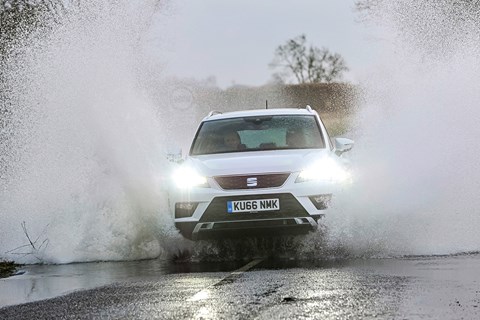
Final big Q: what’s the right spec? We lavished £4210 on options, and here’s where I’d make savings. Drop the £1225 Xcellence pack with its pointless foot-activated boot release and Park Assist (though it works okay), instead buying the brilliantly clear and precise top/rear-view cameras as a single £650 option. The logical, handsome sat-nav (from SE Tech trim up) is splendid.
I’d forego the £805 Advanced Driving Assistance Pack – I’m capable of toggling high beam, more reliable than lane assist at keeping within the white lines to date, and the neurotic anchor-dropping of rear traffic alert is a real pain in the backside. It’s a shame Seat doesn’t offer helpful blind-spot warning and traffic-sign recognition – a useful failsafe in unfamiliar areas – solo. And keyless entry activation on rear door handles too please!
But these are minor gripes. In six months, there was no need to add oil; in fact the only cost was for screenwash. Good to drive, economical to run, solid to the core with quality VW group engineering and excellent value for money, the Ateca transformed my view of the Seat brand. And that Mr Whitworth? Yup, he’s buying one.
By Phil McNamara
Logbook: Seat Ateca Xcellence 1.4
Engine 1395cc 16v turbocharged 4-cyl, 148bhp @ 5000rpm, 184lb ft @ 1500rpm
Transmission 6-speed manual, front-wheel drive
Stats 8.5sec 0-62mph, 125mph, 123g/km CO2
Price £24,440
As tested £28,650
Miles this month 1827
Total miles 12144
Our mpg 36.7
Official mpg 52.3
Fuel this month £180.95
Extra costs £4.99 (screenwash)
Month 5 living with a Seat Ateca crossover: a big Spanish adventure!
Eight lanes of traffic! Eight lanes full of swarming, pestilent lorries, cars and scooters – oh, the scooters – means you need certain things to drive the Avenida Diagonal that slices through the city of Barcelona: the right temperament, a mix of Kimi Räikkönen’s insouciance and Fernando Alonso’s killer instinct for getting the right track position; a reliable sat-nav that directs you onto those arteries at the precise moment (one wrong turn typically means an infernal detour around the city’s uncompromising one-way system); and a compact car that steels you with confidence.
Well, two out of three ain’t bad – and it’s not the Seat Ateca that’s showing the vulnerabilities. We’re now five months into our relationship, which has really blossomed. But if anything can cause a domestic, it’s navigating an international metropolis in the midst of a 2000-mile round trip. On-board, however, there’s a feeling of wellbeing. The golden tendrils of the Barcelona sun reach through the windscreen and double-length sunroof, but A/C Max keeps the 30°C-plus temperatures in check. The driving position is just right: dropped low enough to enhance that connection with the chassis’ centre of gravity, but high enough to get a good view over the surrounding hordes of scuffed superminis. And the windscreen pillars don’t obliterate the three-quarter view as in so many modern cars.
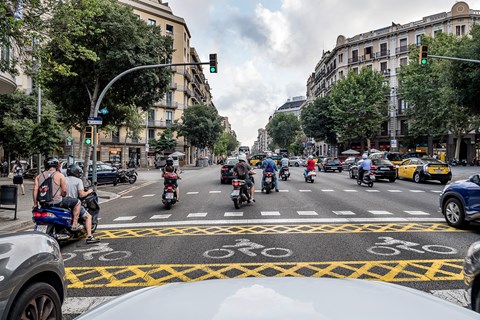
The Ateca is a compact 4363mm long, yet the cabin is roomy: Seat’s tireless UK PR manager takes up the vacant rear perch beside one residual child seat, not requiring any compromise from 6ft 3in snapper Alex Tapley in front. The spacious boot is crammed with lighting pack, tripods, camera bag – and the buckets and spades, beach towels and spare nappy detritus from my family’s preceding Barcelona break (the family having flown in and out).
We’re heading for Seat’s Martorell HQ and factory, specifically a meeting with head of design Alejandro Mesonero-Romanos. Yes, taking a Seat to Barcelona is akin to taking snow to the Inuit, but that’s the point: can we locate a Catalan vibe that shapes Seat styling? And then there’s the journey: how would the Ateca make me feel during those two-day slogs up and down French autoroutes – with a detour to epic Pyrenean roads, naturally? We’ll gloss over the fact that the Ateca’s literal home is the Czech Republic, where Skoda assembles the car for Seat; Martorell builds the Audi Q3 in the topsy-turvey world of VW manufacturing.

The pressing concern is to get there with all body panels intact; in Barcelona, pedestrians have priority over cars turning at traffic lights, which requires the driver to be on high alert. The frequent stopping showcases the faultlessness of the automated handbrake: an exaggerated press of the brake pedal as you stop and a green light in the instrument panel shows the system is engaged; pull away and the brake gently relents. Some cars make this simple act a jerky pantomime, unlike the frictionless Ateca.
If the Seat does have an Achilles’ heel, it’s a wee lack of pulling power below 1800rpm in second and third gear. There have been a number of unkind remarks around the CAR office about the Ateca not having an engine. The blown 1.4-litre petrol’s max torque – 184lb ft – supposedly kicks in at 1500rpm, but it feels a few hundred revs higher and comes accompanied by a subtle serenade of turbocharger whistle. I’ve adapted my technique: hold on to first gear for a clean getaway from the lights, and never expect the Ateca to surge forward in-gear from a steady dual-carriageway cruise. You get used to that, and you also appreciate the near-silent idling, absence of motorway drone and willingness to rev at the redline.
We arrive at Martorell unscathed, to be welcomed by Seat’s passionate but pensive head of design. The sunlit viewing quadrangle harbours Mesonero-Romanos’s entire Seat portfolio, from the 2012 Leon that introduced the current design language to the 20V20 concept hinting at next year’s seven-seat SUV. As well as our Ateca, there’s an Ibiza, Arona and Ateca X-Perience.
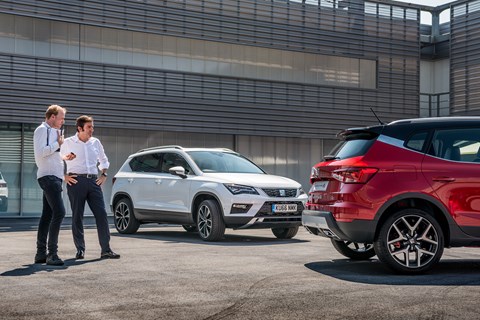
Mesonero-Romanos talks me around the Ateca. Key elements of the Leon – the triangular headlamps and grille, the strong side crease and the tiered bodysides – are deliberately mirrored on its sister SUV. ‘And the Ateca respects the codes of an off-roader, something pretty solid, quite robust, quite classical,’ says Mesonero-Romanos. ‘We are newcomers so we should respect the SUV codes.’
The Ateca’s stretched waistline is for most of its length parallel to the roofline, and that’s key to making the Ateca look bigger and tougher than it is. ‘On a T-shirt, horizontal lines make you look wider,’ the 49-year-old explains. ‘A line that goes from A to B in one shot makes the car look longer because your eyes take more time to [process] the whole thing. It’s a small trick but it helps.’ The squared-off wheelarches are inspired by the Willys Jeep’s, a functional detail designed to keep mud from clogging the tyres.
It’s revealing to stare at the Ateca in the harsh rays, noting how the upturned surfaces catch the light, boosting the contrast with the shaded areas. ‘The Barcelona sun is extremely strong; we like to play with light and sculpture. The interplay between light and shadow [accentuates] the shapes, helping your brain read it and imagine things.’ Mesonero-Romanos points at the concrete floor: ‘Something that is flat doesn’t communicate with you.’
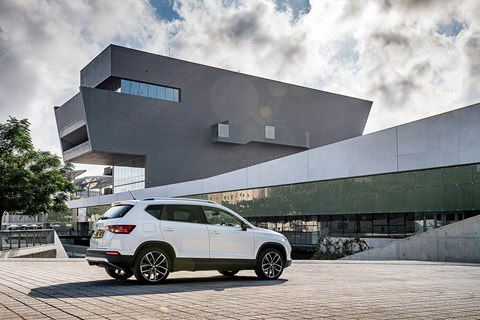
When current company president Luca de Meo joined in late 2015 he asked his design chief to exemplify Spanish design. Mesonero-Romanos responded with a series of sketches of Catalan artefacts, subsequently turned into beautiful artwork which he shows me: the straight lines of the ’60s Montesa Impala motorcycle; the colourful, rippling Parc Güell dragon statue from architect Antoni Gaudi; the beauty and function of Rafael Marquina’s olive oil bottle, with built-in funnel to catch any drops.
After a captivating four-hour seminar, Alex and I drive the Ateca back into Barcelona to soak up Mesonero-Romanos’s influences. Clearly the city – with its elegant and in Gaudi’s case utterly unique architecture, thriving restaurants and doorstep beaches – is a fabulous recruitment tool, and the consistent warmth and sunshine has a deep appeal. Our journey concludes at the Disseny Hub, namechecked by the4 design chief. Its angular frontage of positive and negative planes is striking – and clearly an influence on Seat surfacing.
The next morning we swap the swirling dance of Barcelona’s traffic for the linear procession of the C-16 autoroute through the Llobregat valley. The blue sky frames the towering mountains, whose bleached colour gives them the unreal feeling of a painted backdrop in an am-dram Sound of Music production. The multi-lane highway climbs and climbs, sweeping through occasional tunnels puncturing the rock faces, until we reach about 3000ft. The C-16 drops to one lane and we turn off to sample the N-260, a sinuous strand linking several ski resorts.
In early July the resorts are deserted – as are the roads. The Ateca is dive-bombed by butterflies, and whenever we stop to take photographs all we can hear is the call and response of birdsong. Aside from a cycling team in training, we largely have the road to ourselves. Sure, I would have swapped the 1.4 for a Porsche flat six, but the Ateca is a fun and tactile everyday car. The snappy gearshift has a satisfying mechanical action, like a snooker ball ricocheting into the pocket; the clutch’s bite point is perfectly judged; and when you jump off the brake, the pedal twangs like Wile E Coyote hitting a wall.
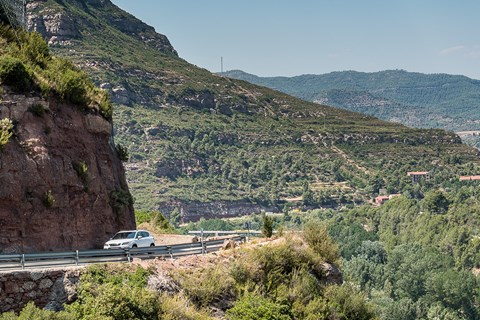
The steering feels heavier than most rivals’, pivoting the nose crisply into corners with the help of the XDS electronics that gently brake the inside wheel. The Ateca feels assured, with less body roll than a Discovery Sport and plenty of lateral grip. Its nose swoops down the diving mountain road, the rear torsion beam axle swaying in its wake over some aggressive camber changes, then we climb again. We peak at around 5800ft above sea level, looking out over the valleys and their pine-covered slopes, hugging the armco. A couple of times it fools the Front Assist sensor into warning of an impending collision, a reminder of the Ateca’s standard-fit automated braking back-up.
Then we descend the sweeping curves hugging the mountainside, passing a couple of Mexican bikers on open corners, and enter the last big town before the border, Puigcerda. Suddenly the road signs change language and the sat-nav helpfully proffers new limits including 10km/h extra grace on the highway: nous sommes en France.
And so begins nearly 700 miles of motorway-hauling to Calais. With the harder driving of the Pyrenean detour and the extra load of Alex and his kit now on board, the return leg reduces fuel economy to 34.3mpg, compared with 35.4mpg on the way to Barcelona. During our two- to three-hour driving stints, we set the cruise control at 130km/h and activate Lane Assist. It allows the Ateca to gently veer between the dotted lines, and on some serious sweeping gradients it feels close to breaking out of the lane. It’s at its most useful on the motorway, where it protests assertively if you threaten to exit your lane without indicating.
We halt the journey overnight in Limoges, kept from our slumbers by fireworks marking the eve of Bastille Day. The morning after, the A20 flows sweetly northbound, but there is epic congestion for those heading south.
On this motorway cruise, the Ateca’s rolling refinement is perfectly fine. Wind noise is the most prevalent sound, and the crossover’s previously noted discomfort with crosswinds and HGV buffeting remains. But road rumble is mostly well suppressed on these French roads, and the ride quality – at times taut in the UK – feels far more relaxed here.
With Alex putting in a shift, I slide the firm but comfortable passenger seat right back, feel the cooling air on my toes, and watch the farmland sweep past as we stream Bonobo on Spotify via the Apple CarPlay interface. Just one criticism: if the screenwash does run low, four alerts in nine minutes is harassment.
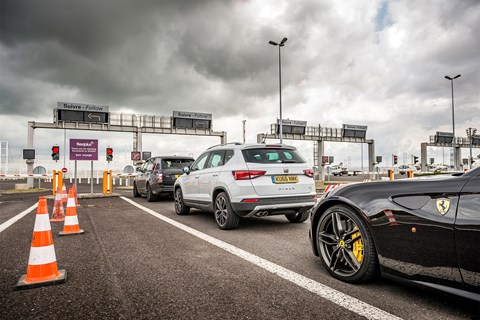
To our relief the Eurotunnel is running smoothly, the M25 anti-clockwise is kind to us for a Friday evening, and after 13 hours on the road today – and €83.49 in tolls – I drop Alex back at his car at Luton Airport. What a trip! The Ateca’s compact size, reliable nav and parking sensor forcefield conquered a foreign city, and winding this dynamically adept crossover through the Pyrenees was as much fun as it would be in a well-sorted hatchback. And those long stints on the autoroute were painless, thanks to agreeable seats, technological creature comforts and respectable economy at 80mph.
‘It’s easy to live with,’ is Alejandro Mesonero-Romanos’s summary of the Ateca’s virtues. The man from Seat, he’s not wrong. In fact, my feelings toward that little Seat are now as warm as the Barcelona sun.
By Phil McNamara
Logbook: Seat Ateca Xcellence 1.4
Engine 1395cc 16v turbocharged 4-cyl, 148bhp @ 5000rpm, 184lb ft @ 1500rpm
Transmission 6-speed manual, front-wheel drive
Stats 8.5sec 0-62mph, 125mph, 123g/km CO2
Price £24,440
As tested £28,650
Miles this month 3164
Total miles 10317
Our mpg 36.1
Official mpg 52.3
Fuel this month £480.82
Extra costs £4.99 (screenwash)
Month 4 with our Seat Ateca crossover: what Ateca tech works?
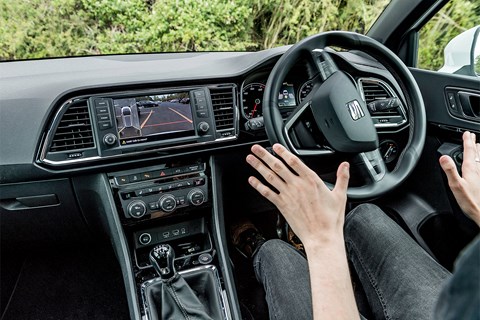
Xcellence by name…
Many of the Ateca’s gadgets are bundled into the £1225 Xcellence pack. Occasionally I use Park Assist for parallel tight spaces. Sadly there’s no beep when you pass a big enough space, so you have to drive with an eye on the instrument panel. The actual parking is eerily human: the Ateca slides into the space, then has a second stab if needed to get tight to the kerb without damaging the rim. Nice.

Braking bad
As with many brands, the vital blindspot detection is an option (here in the £805 Advanced Driving Assistance Pack) – blame its costly radar. Pesky rear cross-traffic alert is also in the pack. Parallel parking outside my house, this can slam on the brakes – not because there’s anything directly behind, but because it’s panicked by oncoming traffic in the other lane. Alarming and infuriating.
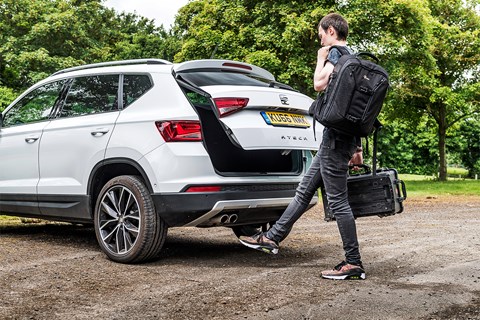
The shin lambada
The significant others in the Xcellence pack are the top-view camera – which appeals to my inner nerd by approximating a bay’s white lines on the screen for fastidious, easy parking – and the tailgate’s virtual pedal. Car makers, enough! It’s goofily hit and miss, making you sway about like a chump, and redundant: even loaded with bags, it’s easy to extend a pinkie and press the boot release.
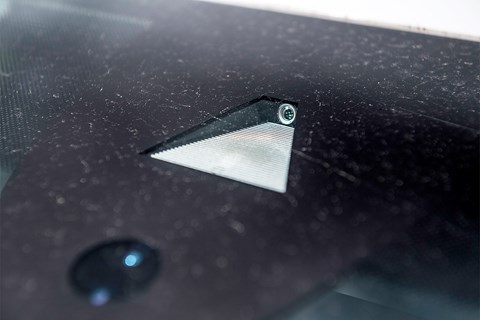
You will stay in lane
Lane Assist comes in four different Ateca packs, including our Advanced Driving Assistance option. Seat’s decent system uses this discreet camera to scan lane markings, and rather than just beeping for a violation it provides a measured dose of steering correction. Typically I keep these things off, but this is worth more investigation…
By Phil McNamara
Month 3 living with a Seat Ateca: economy improvements
We need to talk about fuel economy. Because, for once on a long-term test, I’m happy with it. On daily commutes and a weekend trip to Longleat, the Ateca petrol has kept improving to 35.1mpg – and then I found the Eco button mid-April.
This could be labelled ‘Emasculation’ in some cars, but it has modest impact in the Ateca: feeling like it restricts the throttle opening without making the pedal feel disconnected, and improving air-con efficiency.
Given summer is still around the corner, I’ve further improved air-con efficiency by keeping it off. Throw in more measured driving, plus two cylinders shutting down under light load, and I eked 38mpg out of a tank. That’s 4mpg more than I averaged in the Disco Sport diesel.
By Phil McNamara
Logbook: Seat Ateca Xcellence 1.4
Engine 1395cc 16v turbocharged 4-cyl, 148bhp @ 5000rpm, 184lb ft @ 1500rpm
Transmission 6-speed manual, front-wheel drive
Stats 8.5sec 0-62mph, 125mph, 123g/km CO2
Price £24,440
As tested £28,650
Miles this month 2023
Total miles 5334
Our mpg 34.8
Official mpg 52.3
Fuel this month £318.37
Extra costs £0
Month 2 living with a Seat Ateca: first impressions
I’ve quickly got the measure of the Ateca, both good and niggling. Most importantly, it’s fine dynamically, handling like a sorted estate rather than a roly-poly SUV.
Compare it with Ben Miller’s Ford Edge daily driver: the Seat’s responsive and the consistent steering shames the Ford’s. The Seat can’t match its languid ride though. And with my last four cars having run diesels, the 1.4 petrol’s smooth civility from idle to 4000rpm is welcome.
No point revving it harder as it becomes strained, and short-shifting boosted mpg to 34.6 this month. There are snags, though. The DAB radio loses reception four or five times per commute and this Ateca is sensitive to crosswinds. And despite following the manual’s tips, I can’t get the mirrors to automatically fold when parked.
By Phil McNamara
Month 1 living with a Seat Ateca: the long-term test review introduction
Show me a person with a clear definition of a crossover and I’ll show you someone who works in car marketing. Now that most SUVs have unibody construction, and given you can buy two-wheel-drive Range Rovers and Jeeps, the boundaries have become a wee bit blurred. But if ever there was a crossover, it is our new Seat Ateca.
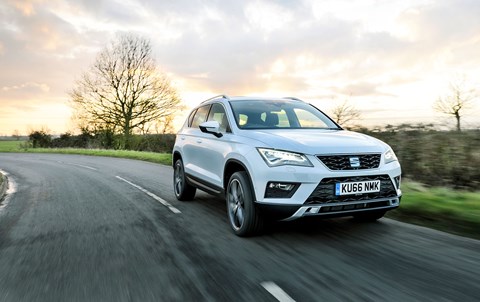
It looks like an estate car after a vigorous session on the rack, with the torturer rearranging its wheelarches too and ramming in 19-inch rims. You will search in vain for a propshaft; only the 2.0-litre diesel can be had with four-wheel-drive capability. This is a slightly higher-riding, taller passenger car weighing 1349kg – a mere Hollywood starlet of mass more than a Leon ST estate.
So we felt we could foresake a diesel’s grunt for the flagship petrol, a 1.4-litre EcoTSI with 148bhp. This turbocharged VW group engine claims to be the world’s first four-cylinder with active cylinder shutdown. Lift-off to cruise and the little ‘eco’ message in the binnacle is the only indication fuel-saving witchcraft’s at work: cylinders two and three have downed tools.
In the lab, the Ateca EcoTSI returns 52.3mpg. My first month of mostly motorway commuting averaged 32.3mpg. Just the cool 20mpg difference, but only 1.5mpg worse than my previous car – a diesel Land Rover Discovery Sport – managed during its year at CAR.
Seat claims the engine delivers 184lb ft of torque at 1500rpm – clearly by Royal Mail though, because forward momentum can be gentler than a Roy Clarke punchline south of 2000 revs. Things pick up fizzily thereafter: the Ateca 1.4 recovers to an 8.5sec acceleration time. Our transmission is a six-speed manual with a springy, eager action; the seven-speed, DSG double-clutch automatic costs an extra £1350.
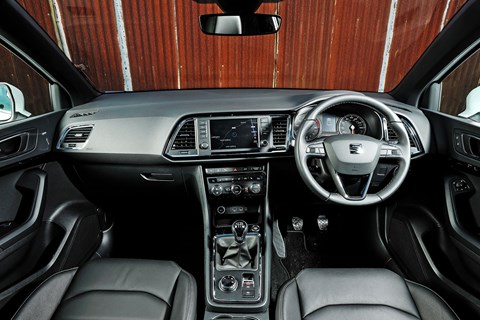
The Ateca range kicks off at £17,990 for a 1.0-litre three-cylinder S. Waltz up through SE and SE Technology trim levels to find our £24,400 Xcellence (sic) model. If this was a paella, it would include truffle oil, lobster and caviar. Uniquely standard items include heated sports seats upholstered in black leather, tinted glass, automated LED headlamps and wipers, rear-view parking camera, keyless entry, a choice of eight interior light colours and wing mirrors that shine Ateca branding by your feet.
We added the £1225 Xcellence pack to our Xcellence model; Seat product planners must be big Bill and Ted fans. The 8-inch colour touchscreen then relays a top-view rendering of the car while manoeuvring (useful for checking you’re within a bay’s outer limits); automated parking and the endlessly amusing ‘virtual pedal’ also figure.
Waggle your foot under the bumper, and the electric tailgate opens and closes. My verdict so far: works fine on the way up, not so well on the way down. You wouldn’t fly with an airline that uses that motto.
Browse Seat Ateca for sale
Standard safety equipment includes radar-based forward collision-warning which can automatically brake the car, and a tiredness recognition system. Both these dozy driver systems are unobtrusive, unlike in some test cars. They contribute to the Ateca’s five-star Euro NCAP rating.
Spend £630 on the Driving Assistance Pack to layer on lane departure warning, speed limits relayed onto the sat-nav screen and blind spot detection. We also added the £1100 panoramic sunroof, for an options total of £4210 and £28,650 all in. Puts the previous incumbent’s £46,615 into perspective, regardless of the Land Rover’s four-wheel drive and seven-seat benefits.
First impressions are of a compact, agile car with slick, linear steering, and a generally comfortable gait undermined by the big rims and slender sidewalls transmitting road imperfections. This petrol crossover feels like a zeitgeisty car to run. With a big question mark over the diesel engine, is this petrol engine a genuine alternative? And what about this VW group car that’s built in the Czech Republic epitomises Seat’s Spanish values? We’ll find out over the next five months.
By Phil McNamara
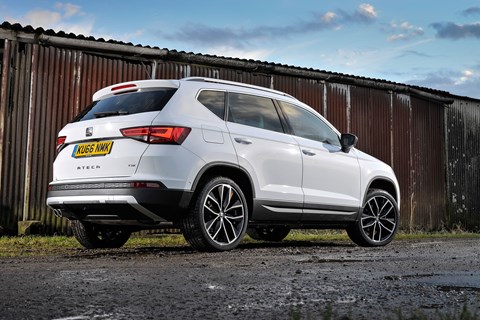
Logbook: Seat Ateca Xcellence 1.4
Engine 1395cc 16v turbocharged 4-cyl, 148bhp @ 5000rpm, 184lb ft @ 1500rpm
Transmission 6-speed manual, front-wheel drive
Stats 8.5sec 0-62mph, 125mph, 123g/km CO2
Price £24,440
As tested £28,650
Miles this month 1173
Total miles 1260
Our mpg 32.3
Official mpg 52.3
Fuel this month £201.34
Extra costs £0
More Seat reviews by CAR magazine